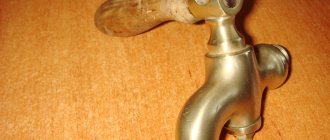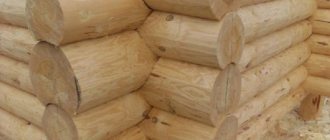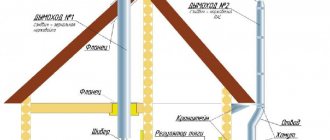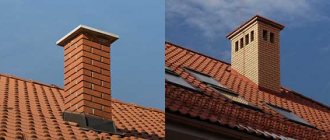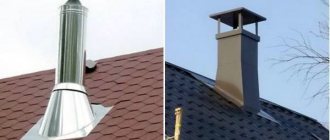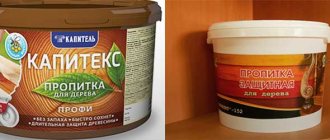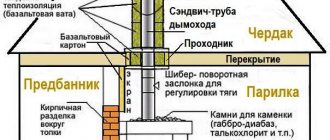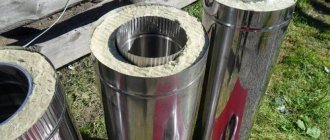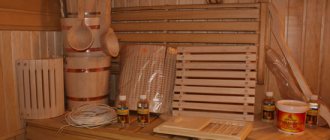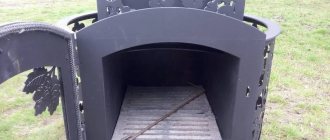Here you will learn:
- Principle of operation
- Types of spark arresters
- Step-by-step construction of a spark arrestor
- Simple spark arrester circuits
- Other spark arrester designs
- Maintenance of spark arresting systems
The spark arrester is designed to extinguish sparks flying out of the chimney when fuel burns in a stove/fireplace.
Usually it is mounted directly on the chimneys of solid fuel stoves, the chimney pipe of a bathhouse, or a special glass for attaching deflectors. This installation is a special nozzle with a metal mesh cylinder and a protective visor on the top.
Spark arrestor value
Often, solid fuel is used to light sauna stoves. Sometimes there is a difference in the quality of the material, which leads to sparking. A spark is a hot particle that does not burn during kindling. With a stream of hot gases, it is directed up the chimney pipe and flies out. This phenomenon can lead to unpleasant consequences.
Sparks very often land on the roof or wooden elements of the building. The wind can blow them several meters around, which leads to the appearance of fires. Dry leaves, pine needles, grass, hay, surrounding structures, trees - all this can catch fire from one spark. To extinguish a hot particle, it is necessary to ensure its contact with elements and surfaces with a high level of thermal conductivity. This way, a red-hot spark will lose its thermal potential even as it moves through the chimney. In other words, it will simply go out.
To achieve premature weakening of the spark thermal potential, a spark arrester is installed on top of the pipe. This element allows you to catch sparks as they come out. A properly made and installed flame arrester reduces the risk of a fire in the bathhouse (sauna) and surrounding buildings.
Installing spark arresters has a number of advantages:
- Provides fire protection when flammable materials are located nearby.
- Prevents sparks from hitting the roof, especially if it is made of flammable materials and a large number of leaves accumulate on it.
- It closes the chimney pipe from precipitation, leaves, and birds, which often like to build nests in it.
- Helps reduce resistance, which eliminates reverse draft and increases the traction force of the chimney.
Advantages and disadvantages
Speaking about the advantages common to all designs, it is worth noting the unimpeded exit of smoke from the pipeline and the preservation of the original draft. In the case of spark arresters-deflectors, the thrust indicator increases.
There are some shortcomings here. For example, this type does not have a deflector umbrella, which prevents precipitation from entering the chimney. The second flaw of such a spark arrester is the absence of a partition that changes the movement of gases along the axis.
How does the spark arrestor element of a chimney pipe work?
The spark arrester has a simple but effective design. It is a nozzle for a chimney, which has a mesh on the sides and a cone on top, providing reliable protection from foreign objects. The spark arrester is installed on any type of chimney. The operating principle of this device is quite simple:
- During the heating of the furnace, the solid fuel material burns. The result is smoke and gas. It is known from physics lessons that air masses rush upward along a free path. In the case of a bath, the formed substances pass through the chimney channel, trying to escape out. In this case, the smoke plumes may contain unburned combustion products, which, like sparks, lead to a fire.
- In the presence of a spark arrester, smoke with hot particles “rests” against the first and main barrier in the form of a protective cone.
- The sparks' direct passage into the air is closed. They head to the sides, where another obstacle in the form of a net awaits them. Hot particles under pressure seep through the cells, losing the accumulated thermal potential.
The whole principle of operation of a conventional spark arrestor consists of three simple steps that protect owners from fire. You can make such a device yourself without spending a lot of money.
Maintenance of spark arresting systems
Like any simple mechanism, the spark arrester requires routine maintenance, which consists of the following:
- Inspection of the integrity of the entire structure. At least once a year.
- Cleaning the main components and assemblies from soot and other deposits. Twice a year.
- Unscheduled inspection and cleaning. For example, in areas with an abundance of common poplar, the fluff of this tree is able to clog the spark arrester mesh to a dense fiber state. In addition to deteriorating traction, such a nozzle is also a fire hazard. Such work must be carried out as an objective need arises and is not regulated by specific deadlines.
By the way! Work on maintenance and repair of spark arresters is classified as high-altitude, so their implementation must be ensured by strict compliance with the rules and safety requirements.
Systems made of ferrous metal under conditions of different temperature loads and condensation formation have a tendency to increased corrosion, which predetermines closer service attention to them than in relation to systems made of stainless steel.
Main models
The elements of the chimney that ensure the elimination of hot incandescent particles are different. At home, as a rule, two types of spark arrestors are used:
- Stainless steel casing, which is a mesh structure. You can do it using improvised means.
- Deflector. In addition to extinguishing solid hot particles, it improves traction by redirecting the wind flow. Protects the stove device and bathhouse from a dangerous phenomenon - backdraft as a result of strong winds.
The damper in the form of a casing is the most popular, since its design is quite simple. Holes are made in the pipe or a special nozzle in the form of a mesh is attached to it. The disadvantage of this design is the frequent revision of the spark arrester device. Perforated mesh quickly becomes clogged, as combustion products settle on their surface. The higher the degree of contamination, the less draft in the pipe. The spark arrestor, made in the form of a casing, is subject to frequent cleaning. On sale there are assembled casings for extinguishing sparks. Their advantage is their easy connection to the chimney pipe.
More modern devices are spark arresting devices - deflectors. Externally they look more aesthetically pleasing. When using deflectors, the draft in the chimney is not reduced. Such absorbers are equipped with mesh and perforation. Their distinctive feature is the presence of narrowing points, which allow increasing traction inside the spark arresting element. Depending on the location of the narrow sector, there are various models of dampers, many of which are very similar in appearance to the casing, but are more aerodynamic. The disadvantage is that it gets dirty quickly and requires frequent cleaning, especially when using resinous logs as fuel.
Reasons for needing installation
Such a device is installed in accordance with fire safety and building codes and regulations.
Below is a list of all conditions for installing the structure:
- the use of boilers operating on solid fuel, various stoves and fireplaces, as well as devices that provide heating and supply of hot water;
- buildings in which the temperature reaches the highest levels; these include various saunas and baths;
- structures for the construction of which flammable materials are used.
Distinctive properties
When installing a spark arrester on the chimney of a bathhouse, you need to know what main features this device has:
Installation of spark arresters is advisable only in bathhouses heated by solid fuel stoves. The view doesn't matter.- A mesh is installed along the side surfaces of the device. The cell size is no more than five millimeters. With large opening areas, there is a possibility of hot particles leaking through the trap. It is also impractical to make them too small, as the mesh will quickly become dirty. The passage of smoke is obstructed, which can lead to the accumulation of caustic vapors inside the steam room.
- Installation of a spark arrestor is mandatory if there is a roof made of flammable materials.
- Installation of the device is required when the chimney is located in a straight direction. The condition applies to baths and saunas.
- Installed to protect the chimney from nesting birds and foreign debris.
- The catcher mesh undergoes frequent cleaning, since all particles that were not burned during the combustion process settle on it. The spark arrestor requires especially careful care when using resinous logs as fuel.
All of the listed distinctive properties of spark arresters characterize this device as one of the main elements responsible for fire safety.
Protecting the wall from overheating
During operation of a sauna stove, its surface temperature can reach 400 degrees and above.
In addition, it emits infrared rays, heating the walls of the room, especially those closest to it.
If the wall decoration is made of wood, then its constant overheating can lead to charring and fire.
To prevent this, special fire-retardant compounds are used, and for greater reliability, a protective screen is installed for the stove in the bathhouse. The most popular materials for its manufacture:
- Metal. Insulation of walls in a bathhouse from the stove is most often done using a metal screen. They are mainly frontal or lateral. Metal screens significantly reduce the temperature impact on the walls;
- Brick. Brick protective screens can both reduce radiation from the stove in the bathhouse and protect walls from prolonged exposure to high temperatures. Brick for sauna stoves has been used for a long time because it takes a long time to heat up, then gives off soft heat to the room, cooling down for a long time;
- Stainless steel sheets. This material is used to cover both the furnace and surrounding elements. If a stainless steel sheet is thoroughly polished, its mirror surface will reflect harmful infrared radiation.
The process of making a device with your own hands
You can make a simple spark arrestor with your own hands. Before you start creating a device for a chimney, you need to prepare all the necessary tools and materials:
- Stainless steel sheet with a thickness of 0.5 to 1 centimeter.
- Rigid mesh made of durable metal.
- Rivets are preferably made of steel.
- Scissors for cutting metal.
- Welding device.
- Angle grinder.
The sequence of operations is as follows:
- Measure the chimney opening.
- Make a preliminary sketch of the future spark arrester, taking into account all the components.
- Cut out mock-ups of the parts that make up the device from cardboard.
- Attach cardboard templates to a sheet of metal and carefully cut out analogs. In this case, dimensional accuracy must be observed.
- The mesh can be made from metal rods with a thickness of one to six millimeters. The possibility of using a finished product is acceptable.
- Connect all existing joints by welding. Clean them with a grinder.
- Secure all parts with strong rivets. The best option is made of steel.
- Install the spark arrester on the chimney pipe. Secure it carefully so that it does not blow away in a strong gust of wind.
- If desired, a deflector can be attached to the spark arrester.
- Using special scissors, cut out a visor from a metal sheet, which is subsequently bent at the desired angle. Secure all folds with rivets.
- Fasten the manufactured cone and the base of the device together. For fixation it is advisable to use steel rivets.
Creation of a deflector type spark arrester
Deflector designs are more effective compared to mesh models of spark arrestors. The Tsaga deflector with an apron that captures hot, incandescent particles is very popular. To create it you need:
Cut out a cardboard template of the proposed design. You will need it when cutting metal.- Measure the diametrical size of the chimney pipe.
- The inside of the spark arrester is a pipe with a diameter larger than the chimney. If the required workpiece is not available, it must be made from a stainless steel sheet.
- Roll out the upper edge of the sleeve being created, since its diametrical size should exceed the lower one.
- Make a casing shell from a piece of pipe. Using metal plates, attach it to the sleeve.
- At a six-centimeter distance below the casing, attach an apron whose diameter exceeds the casing. Otherwise, the spark arrester will be ineffective. In appearance, the part resembles a curved plate, which serves as the main component responsible for catching sparks.
- It is necessary to make special holes in the apron through which accumulated water will subsequently drain.
- Attach the cover over the top casing side using rivets. For them, drill the required number of holes in the right places in advance.
- Attach the created spark arresting device to the pipe. It is imperative to check the strength of the structure so that it can withstand strong gusts of wind.
- Additional strength and durability can be provided by attaching several rolled stiffeners.
Additional options on how to protect your sauna from sparks
In addition to installing a spark arrestor, there are several other options for protecting the bath:
- The simplest and most common method is to weld the chimney pipe tightly. A large number of holes are drilled in the upper part to allow smoke and gas to escape. This method is also suitable for a pipe installed on an existing one.
- The second option to protect the building and surrounding buildings from fire as a result of a falling spark is to weld a metal mesh at the end of the chimney pipe. The disadvantage of this design is rapid contamination, leading to weakening of traction. Frequent replacement with a new mesh will be required.
- To prevent return draft as a result of strong winds, a deflector is installed on the chimney pipe.
- When building a chimney, the structure is often made with bends. Hot particles ejected from the furnace are extinguished along the way, without reaching the top of the pipe. In addition to extinguishing, the chimney with elbows provides the steam room with additional heat.
All of the above methods have a simple design, so you can create them yourself, using improvised means, without spending a lot of money. All of them are effective and fully provide protection for the bathhouse roof and surrounding buildings from dangerous fires resulting from the ingress of a hot particle. You can install a spark arrester of any type in a short time, but the effect will be significant.
Ceramic chimney in a bathhouse: installation features
The arrangement of your own bathhouse should be subject not so much to aesthetic standards as to fire safety standards, which primarily depend on the correct design of the stove. One of the most important components of a stove system is a high-quality smoke exhaust system. Recently, its most popular variation is considered to be a ceramic chimney for a bathhouse, the installation of which has some features.
Use of ceramics in furnace systems
Modern production produces high-tech ceramic pipes for chimneys, the use of which can solve several problems at the same time. They are mainly used for gas removal and installation on liquid and solid fuel boilers. But in addition to the standard ones, they also produce narrowly targeted smoke exhaust pipes made of ceramics, intended only for boilers with low temperatures.
Ceramic chimney pipes are characterized by several advantages and technical nuances:
- High resistance to frequent temperature changes;
- Versatility;
- Possibility of installation on various structures;
- Simple processing;
- Relatively easy installation;
- High fire safety;
- Absolutely waterproof;
- High-quality accumulation of thermal energy;
- Gas density;
- Mechanical reliability;
- Durability. Manufacturers guarantee a ceramic service life of up to 30 years.
The positive characteristics of ceramic pipes place them in a leading position among similar structures.
Design features
Ceramic chimneys consist of three layers. Before hitting the counter, they all undergo certification, based on the results of which they are assigned special indices. In order to determine whether a certain design is suitable for a sauna stove, you need to understand the meaning of each icon. An example of indexing a ceramic chimney is the following inscription: T600-N1-D-3-G100, where
- T600 means the system has been tested at 700 degrees and is suitable for operation at 600 degrees;
- N1 – indicator of the chimney’s tightness to gas leakage at internal pressure;
- D – design can be used with dry smoke;
- 3 – maximum resistance to acid deformation;
- G – the chimney has been tested when soot ignites at 1000 degrees;
- 100 – the gap between combustible structures and the walls of the chimney.
Installation
The arrangement of a ceramic chimney in a bathhouse has its own characteristics. The installation itself is not particularly difficult. It flows from bottom to top, and the inner part of the upper pipe should fit into the middle of the lower one.
Preparation for installation
Work begins with determining the connection point. The base for the chimney must be perfectly horizontal and level. The base is filled with cement mortar, after which a module with outlet elements for connecting a boiler or stove is fixed. This is where the groove for removing condensate is located.
Chimney connection
First, an acid- and moisture-resistant composition for seams is prepared from water and a special powder in a ratio of 1:7. The solution is mixed at a temperature of +20 degrees and used within the next 1.5 hours. It is absolutely not recommended to add water to an already hardened solution!
Then the tee is installed on the module with the pipe, and the connection point is thoroughly coated with the solution. The presence of a tee in the chimney will ensure trouble-free inspection and cleaning of the pipes.
Now fix the remaining parts of the chimney, smooth the joints with a damp sponge. This will provide a smooth surface on the internal seams, on which soot will not linger and settle.
Pipe lining
Experts do not recommend using fire-resistant plasterboard, gypsum fiber board or glass magnesite for lining a ceramic chimney in a steam room. For example, the latter material contains a lot of magnesium chloride, which releases hydrogen chloride in a humid environment and is very dangerous to human health.
The best option for cladding is considered to be CPS (chip-cement boards). They are fixed before installing the ceramic structure. The sealant is applied from a construction gun into the upper groove of the pipe. It does not need to be wetted - just remove excess sealant when installing the next element. During installation, it is necessary to regularly check the verticality of the structure.
Consolidation
Strengthening the pipe is necessary if it rises 150 cm above the roof. To do this, use steel sections with a cross-section of 1 cm or iron corners with steel tape. The result should be an external welded corset that will hold the chimney sliding in it.
Decoration
To decorate the upper part of a ceramic chimney, facing bricks, tiles, slates, and square masonry made of heavy concrete are used. Although, you can choose other non-combustible materials.
